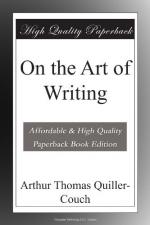To begin with, let me plead that you have been told of one or two things which Style is not; which have little or nothing to do with Style, though sometimes vulgarly mistaken for it. Style, for example, is not—can never be—extraneous Ornament. You remember, may be, the Persian lover whom I quoted to you out of Newman: how to convey his passion he sought a professional letter-writer and purchased a vocabulary charged with ornament, wherewith to attract the fair one as with a basket of jewels. Well, in this extraneous, professional, purchased ornamentation, you have something which Style is not: and if you here require a practical rule of me, I will present you with this: ’Whenever you feel an impulse to perpetrate a piece of exceptionally fine writing, obey it —whole-heartedly—and delete it before sending your manuscript to press. Murder your darlings.’
But let me plead further that you have not been left altogether without clue to the secret of what Style is. That you must master the secret for yourselves lay implicit in our bargain, and you were never promised that a writer’s training would be easy. Yet a clue was certainly put in your hands when, having insisted that Literature is a living art, I added that therefore it must be personal and of its essence personal.
This goes very deep: it conditions all our criticism of art. Yet it conceals no mystery. You may see its meaning most easily and clearly, perhaps, by contrasting Science and Art at their two extremes—say Pure Mathematics with Acting. Science as a rule deals with things, Art with man’s thought and emotion about things. In Pure Mathematics things are rarefied into ideas, numbers, concepts, but still farther and farther away from the individual man. Two and two make four, and fourpence is not ninepence (or at any rate four is not nine) whether Alcibiades or Cleon keep the tally. In Acting on the other hand almost everything depends on personal interpretation—on the gesture, the walk, the gaze, the tone of a Siddons, the ruse smile of a Coquelin, the exquisite, vibrant intonation of a Bernhardt. ‘English Art?’ exclaimed Whistler, ’there is no such thing! Art is art and mathematics is mathematics.’ Whistler erred. Precisely because Art is Art, and Mathematics is Mathematics and a Science, Art being Art can be English or French; and, more than this, must be the personal expression of an Englishman or a Frenchman, as a ‘Constable’ differs from a ‘Corot’ and a ‘Whistler’ from both. Surely I need not labour this. But what is true of the extremes of Art and Science is true also, though sometimes less recognisably true, of the mean: and where they meet and seem to conflict (as in History) the impact is that of the personal or individual mind upon universal truth, and the question becomes whether what happened in the Sicilian Expedition, or at the trial of Charles I, can be set forth naked as an alegebraical sum, serene in its certainty, indifferent to opinion, uncoloured in the telling as in the hearing by sympathy or dislike, by passion or by character. I doubt, while we should strive in history as in all things to be fair, if history can be written in that colourless way, to interest men in human doings. I am sure that nothing which lies further towards imaginative, creative, Art can be written in that way.




